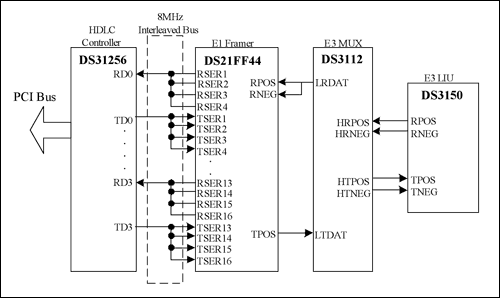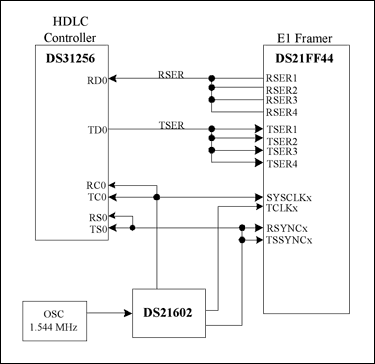Interleaved Bus Operation
Abstract: This applicaTIon note shows how to configure the Interleaved Bus OperaTIon (IBO) with the DS21FF44 framers by using the DS31256 HDLC controller onto a PCI bus. Other Dallas Semiconductor framers and transceivers will be used as well.
OverviewThis applicaTIon note describes how to configure an E1 framer for Interleaved Bus OperaTIon (IBO). Interleaved Bus Operation (IBO) is designed for multiplexing data streams from numerous devices onto a single bus. The DS21FF44 framers will be used with a DS31256 HDLC controller onto a PCI bus (Figure 1). Other Maxim / Dallas Semiconductor T1 / E1 framers and transceivers will also be featured. The hardware connections will be identical on a T1 framer.

Figure 1. Example of an 8.192MHz interleaved bus in byte mode. Hardware Figure 2 illustrates a normal configuration of hardware connections. If the application requires frame interleaving, then TCLK and RCLK must be frequency-locked to TSYSCLK and RSYSCLK (ie, frame slips cannot occur). Frame slips are acceptable in byte-interleaved applications. Also, RSYNC and TSSYNC must be tied together. (In IBO mode the receiver is not independent of the transmitter.)

Figure 2. Connections for IBO mode.
The sync pulse must be phase-locked to the 8.192MHz clock, as shown in Figure 3. The hardware for a T1 framer differs only in the use of a 1.544MHz clock to connect to TCLK / RCLK instead of an E1 frequency clock. Further , in T1 every fourth channel is unused and forced to 0xFF. Consult the IBO section in the T1 data sheet for details.

Figure 3. Timing diagrams for IBO mode.
Refer to Section 22 of the DS21FF44 data sheet for additional timing diagrams. More information about the IBO can be found in Section 20 of the data sheet. SoftwareThe chip must be configured for IBO functionality. Configuration includes the setting the IBO registers, enabling the elastic stores, and configuring TSYNC and RSYNC correctly. (See the detailed register listing in the Table 1 below.) Additionally, users must select the 2.048MHz mode for the system clocks (for both T1 and E1 framers).
Table 1. The Bits That Must Be Set on All 16 Framers
ConclusionThis application note has shown how to configure a DS21FF44 for Interleaved Bus Operation (IBO) with various Dallas Semiconductor HDLC controller, E1 framer, and transceiver devices.
If you have further questions about our framers, transceivers or HDLC controller products, please contact the Telecommunication Applications support team by email at: var name = "telecom.support @"; var domain = "dalsemi.com"; document.write (" "+ name + domain +" "); telecom. or call 01-972-371-6555.
OverviewThis applicaTIon note describes how to configure an E1 framer for Interleaved Bus OperaTIon (IBO). Interleaved Bus Operation (IBO) is designed for multiplexing data streams from numerous devices onto a single bus. The DS21FF44 framers will be used with a DS31256 HDLC controller onto a PCI bus (Figure 1). Other Maxim / Dallas Semiconductor T1 / E1 framers and transceivers will also be featured. The hardware connections will be identical on a T1 framer.

Figure 1. Example of an 8.192MHz interleaved bus in byte mode. Hardware Figure 2 illustrates a normal configuration of hardware connections. If the application requires frame interleaving, then TCLK and RCLK must be frequency-locked to TSYSCLK and RSYSCLK (ie, frame slips cannot occur). Frame slips are acceptable in byte-interleaved applications. Also, RSYNC and TSSYNC must be tied together. (In IBO mode the receiver is not independent of the transmitter.)

Figure 2. Connections for IBO mode.
The sync pulse must be phase-locked to the 8.192MHz clock, as shown in Figure 3. The hardware for a T1 framer differs only in the use of a 1.544MHz clock to connect to TCLK / RCLK instead of an E1 frequency clock. Further , in T1 every fourth channel is unused and forced to 0xFF. Consult the IBO section in the T1 data sheet for details.

Figure 3. Timing diagrams for IBO mode.
Refer to Section 22 of the DS21FF44 data sheet for additional timing diagrams. More information about the IBO can be found in Section 20 of the data sheet. SoftwareThe chip must be configured for IBO functionality. Configuration includes the setting the IBO registers, enabling the elastic stores, and configuring TSYNC and RSYNC correctly. (See the detailed register listing in the Table 1 below.) Additionally, users must select the 2.048MHz mode for the system clocks (for both T1 and E1 framers).
Table 1. The Bits That Must Be Set on All 16 Framers
| DS21FF42 / FT42 DS21Q44 DS21354 / 554 Registers | DS21352 / 552 DS21Q42 Registers | Comment |
| RCR1.5 = 1 | RCR2.3 = 1 | RSYNC is an input. |
| RCR2.1 = 1 | CCR1.2 = 1 | Receive elastic store is enabled. |
| RCR2.2 = 1 | CCR1.3 = 1 | RSYSCLK is 2.048 / 4.096 / 8.192 MHz. |
| TCR1.0 = 1 | TCR2.2 = 1 | TSYNC is an output. |
| CCR3.1 = 1 | CCR1.4 = 1 | TSYSCLK is 2.048 / 4.096 / 8.192 MHz. |
| CCR3.7 = 1 | CCR1.7 = 1 | Transmit elastic store is enabled. |
| IBO = 0x09 | IBO = 0x09 | IBO enabled, byte mode, master devices (framers 1, 5, 9, 13) |
| IBO = 0x08 | IBO = 0x08 | IBO enabled, byte mode, slave devices (framers 2-4, 6-8, 10-12, 14-16) |
If you have further questions about our framers, transceivers or HDLC controller products, please contact the Telecommunication Applications support team by email at: var name = "telecom.support @"; var domain = "dalsemi.com"; document.write (" "+ name + domain +" "); telecom. or call 01-972-371-6555.
Down Tube Battery,Ebike Lithium Battery,24V Bottle Battery,24V Electric Bicycle Battery
Changxing Deli Technology Co., Ltd. , https://www.delipowers.com